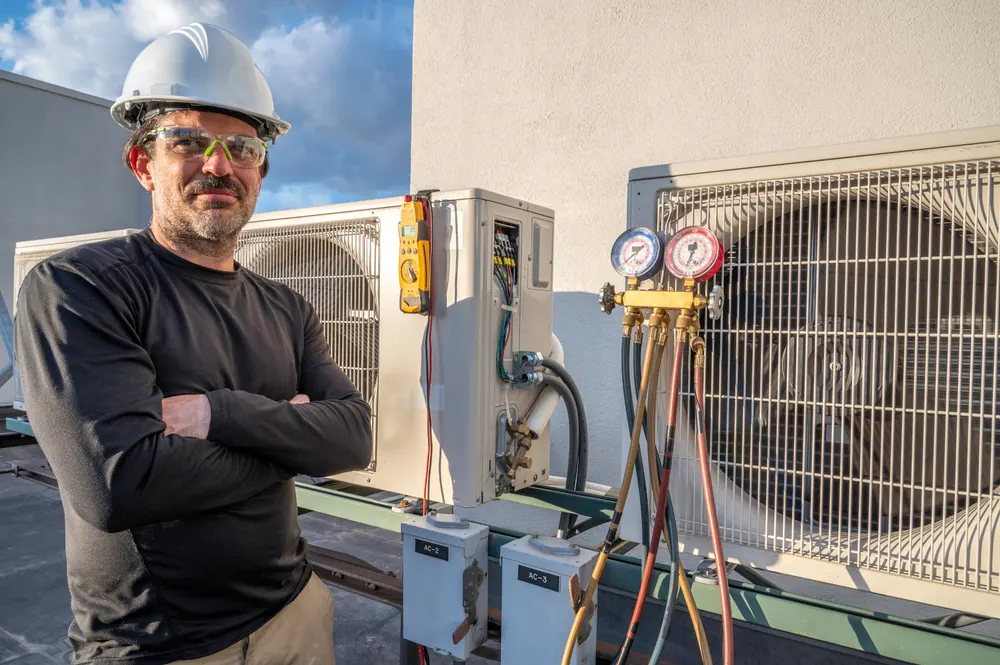Working principle of mini split Air-conditioning system
Ductless Mini split air conditioner systems are so popular all over the world. It doesn’t require any ductwork, which makes it easier to install. There are other air conditioning systems like VRF and Chiller, and each of them is made for different use criteria. For over 1000 ton requirement we suggest a Chilled water system and for Commercial, bungalow areas VRF system is preferable. As a project coordinator, I have worked in so many VRF and chiller projects, but at the beginning of my career, I also worked with mini split air conditioning system. Mini split is used for small homes, garages, etc areas. For this kind of area, if we use other air conditioner systems, then the cost will increase 5/10 times or more, which is illogical. That’s why in the beginning I told every different air conditioning system used for different use criteria. Due to mini-split availability people acknowledge it, but still a lot of people don’t know about the working principle of mini-split AC or how it keeps a house cool. In this blog, I will explain those things and I believe there will be no more confusion after reading this blog.

A mini split AC has two parts: an Indoor unit and an outdoor unit. The indoor unit’s parts are the evaporator, blower fan, and EEV(electronic explanation valve).
And compressor, condenser, blower fan, and expansion valve are part of the outdoor unit.
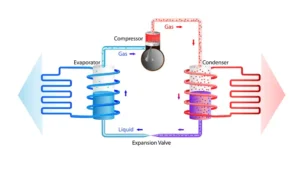
In operation, chilled liquid refrigerant from the outdoor unit enters the evaporator. During this time, the blower fan pulls warm room air across the evaporator. In the evaporator, the chilled liquid refrigerant absorbs heat from the room air through heat exchange, cooling the room. After absorbing the heat, the liquid refrigerant converts into gas, which flows through copper pipes to the compressor. The compressor compresses this low-pressure gas, turning it into superheated high-pressure gas.
This high-pressure gas then flows to the condenser. The blower fan directs high-speed air across the condenser pipes to absorb the refrigerant’s heat. In the condenser, the superheated gas cools and then passes through an expansion valve, which expands the cooled refrigerant, turning it into liquid form. This liquid refrigerant flows to the evaporator through the EEV (electronic expansion valve).
This liquid refrigerant goes to the evaporator through EEV (electronic expansion valve). Now the question is what does EEV do?
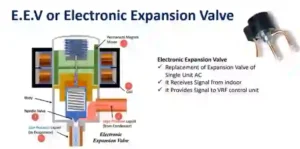
Imagine your room has a 2 ton (24000 BTU) air conditioner. Now some time your room requirement will be 1 ton and sometime it will be 2 tons. Because all the time you will not use your air conditioner in full capacity. For example in winter you will keep the air conditioner in very low power. Because due to weather change your room requirement is no longer 2 ton. We use remote to control the temp of the air conditioner.
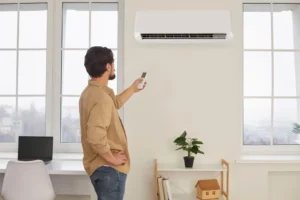
For more capacity your air conditioner will need more refrigerant. So when you run your air conditioner on low power, a low amount of refrigerant enters the evaporator.
It is the EEV which controls the refrigerant flow in the Evaporator(indoor unit) as per your requirement or usage of your remote. The air conditioner EEV works like a valve. Spouse you keep your air conditioner temperature in medium, you are using 50 percent of your capacity. In this situation, you can run your 2-ton capacity air conditioner into 1 ton by using a remote/Thermostat and this is possible due to EEV. Without EEV it isn’t possible to control your air conditioner with a remote/ Thermostat.
Convertible and Non-Convertible Mini Split :
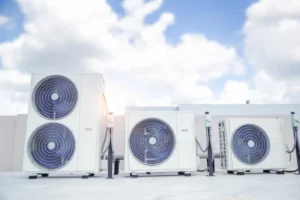
There are two types of mini split air conditioners: convertible and non-convertible. If you run a non-convertible air conditioner for 12 hours, the compressor will run continuously, consuming more electricity. This type is used in areas where a constant temperature is needed, like a server room.
In a convertible mini split system, the compressor changes its speed based on the room’s temperature needs, making it more energy-efficient. Convertible mini splits are preferable for homes or small office spaces. Though they cost more than non-convertible units, they’re worth the investment.
Advantages of Mini Split Air Conditioners:
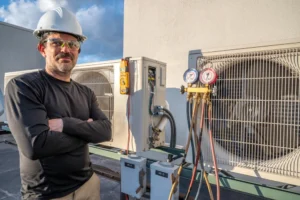
Mini-splits offer several advantages:
– Availability and cost-effectiveness
– Easy installation
– No ductwork required, allowing easy wall installation
– Lower electricity consumption
– Reduced noise
– Better control systems
– Long life expectancy (almost 10 years)
Disadvantages of Mini Split:
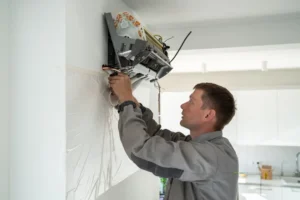
However, mini-splits have some limitations:
– Limited range (each room requires a separate indoor unit)
– Installation complexity (it takes 3-4 hours to install a mini split AC, and only an expert technician can do it properly. If you want to install it yourself, read my blog on the mini split installation process).
– Higher electricity consumption compared to VRF and chilled water systems
– Regular maintenance required every 3-4 months
– Not suitable for large commercial spaces, as multiple outdoor units would be required, which would look unattractive on a building.
Some people think mini splits are expensive to install, but this comparison often involves window or portable ACs, which can’t fully meet the requirements of a mini split. So, it’s not fair to compare the two. Mini-splits are affordable for their intended use.
When to Choose a Mini Split:
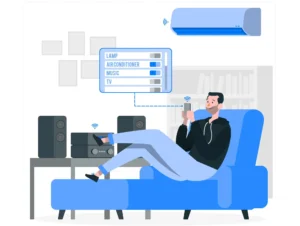
Mini split air conditioners are ideal for small areas. With a mini split, you can control the temperature in a single room, not the whole house. If you have a large house, bungalow, office, or garage, you might want to consider a VRF (central air conditioning) system. Mini splits are best suited for small rooms, personal garages, and small office areas.
The popularity of mini splits is due to their low-cost installation and wide availability. The longevity of your unit depends on proper installation. If the outdoor unit isn’t mounted securely, it may vibrate when the blower fan runs, causing the compressor to overheat, which can lead to damage.
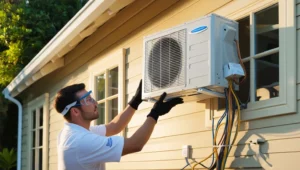
An expert technician can install it within 3 hours. However, if you’re tech-savvy and want to try installing it yourself, or if you want to understand the installation process before buying, I recommend reading my blog “Installation Process of a Mini Split Air Conditioner.”
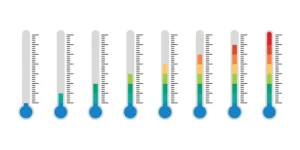
When you are choosing a mini-split air conditioning system, there are many factors to consider, like the height of your room, the temperature of your area, the square footage of your room, the insulation factor of your room, the number of people in the room, and the mechanical equipment present. The seller can guide you based on your specific conditions.

